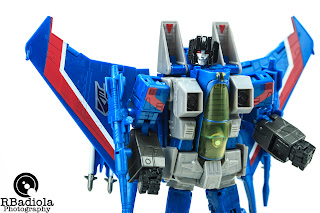 |
| Masterpiece Thundercracker Transformer |
As a toy collector I was delighted to see that they finally released the Masterpiece Thundercracker Transformer as a ToysRus exclusive. The Takara version of it (Japan version) has become way too expensive for me...around $200 and higher from independent sellers. So when this was released here I snagged a copy right away before the prices go up.
After getting the toy about 4 days later, I set it up in the studio. For studio shots like this, I use the Canon 100mm f/2.8 macro for maximum sharpness. Working in a studio for shots like this, you don't really need a zoom lens since the subject isn't moving at all. Prime lenses are excellent for these kinds of scenarios so primes are my primary choices for product shots like this. I have a small studio so when my 100mm is too close for the subject and I don't have any more room to move, I switch to my 50mm.
As usual I used 3 strobes for this shot. Two strobes on each side and one on top. I used the strobe on my left side as my main light and the right one for fill. For the fill I usually set the power to half or less of what my main lights power is. The top light is just used to create some shadows to make the subject more three dimensional and not flat.
For studio shots like this I usually set my shutter speed to 100th/sec which is enough for static subjects like this. For photographing droplets or something moving, I usually use a higher shutter speed. I adjusted my fstop according to my lighting and ended up somewhere between f/5.6 to f/7.1. My average was around 6.3. With that range I get enough depth of field without me being worried about diffraction, which sets in at narrower fstops.
I love photographing objects like these because of the contours of the subject. The contours show up depending on your lighting. When photographing objects like these just make sure that the shadow areas aren't really heavy and not totally black..not unless you are looking for that kind of look.
After shooting, post processing always brings out more details. The contours seem to pop more and the colors become more vibrant. Just be careful not to over process as doing that makes the shot look very artificial.











